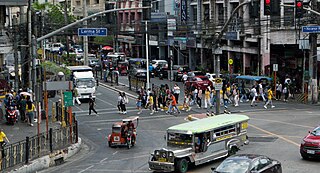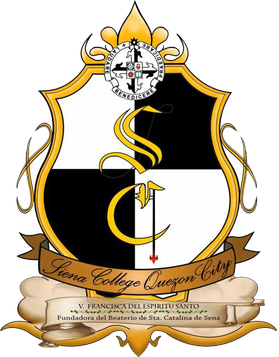
Sampaloc is a district of Manila, Philippines. It is referred to as the University Belt or simply called "U-Belt" for numerous colleges and universities are found within the district such as the University of Santo Tomas, the oldest extant university in Asia; the National University, the first private nonsectarian and coeducational institution in the Philippines; the Far Eastern University, known for its Art Deco campus and cultural heritage site of the Philippines; and the University of the East, once dubbed as the largest university in Asia in terms of enrollment. The district is bordered by the districts of Quiapo and San Miguel in the south, Santa Mesa district in the south and east, Santa Cruz district in the west and north, and Quezon City in the northeast.

The Colegio de San Juan de Letran, also referred to by its acronym CSJL, is a private Catholic coeducational basic and higher education institution owned and run by the friars of the Order of Preachers in Intramuros, Manila, Philippines. It was founded in 1620. Colegio de San Juan de Letran has the distinction of being the oldest college in the Philippines and the oldest secondary institution in Asia. The school has produced Philippine presidents, revolutionary heroes, poets, legislators, members of the clergy, jurists, and it is also one of the only Philippine schools that has produced several Catholic saints who lived and studied on its campus. The school's patron saint is St. John the Baptist. The campus contains two statues, representing the two foremost alumni in the fields of secular and religious service: former Philippine President Manuel L. Quezon and Vietnamese Saint Vicente Liem de la Paz.

Siena College of Quezon City is a private, sectarian, non-stock basic and higher education institution run by the Congregation of the Dominican Sisters of St. Catherine of Siena in San Francisco del Monte, Quezon City, Philippines. It was established in 1959 by the Siena Sisters. The school offers tertiary education with degrees in Tourism, Business Administration, Hotel and Restaurant Management, Mass Communications, and Religious Education. It also offers pre-school, elementary, secondary education, and SPED.

The Congregation of the Religious of the Virgin Mary (Spanish: Religiosas de la Beata Virgen María, abbreviated RVM, is a Roman Catholic centralized religious institute of consecrated life of Pontifical Right for women founded in Manila in 1684 by the Filipina Venerable Mother Ignacia del Espíritu Santo.

The Santa Isabel College, also referred to by its acronym SIC, is a private, Roman Catholic college owned and operated by the Sisters of Charity of Saint Vincent De Paul in Ermita, Manila, Philippines. It was founded on 24 October 1632. Santa Isabel College is one of the oldest colleges in the Philippines and in Asia.

The University Belt is the name of a de facto subdistrict in Manila, Philippines, referring to an area that has a significant concentration of major colleges and universities in the city. The districts of Quiapo, Sampaloc, and San Miguel are traditionally considered to be the University Belt, although other clusters of schools that lie along the southern bank of the Pasig River, mostly at the districts of Intramuros and Ermita, as well as the southernmost part of Malate near the city limits are also sometimes included. Each of the colleges and universities found in the district are a short walking distance of each other.

St. Mary's College Inc., also referred to by its acronym SMCQC or as St. Mary's College, is a private Catholic basic and higher education institution for both boys and girls administered by the Religious of the Virgin Mary in Mother Ignacia Avenue, Quezon City, Philippines. It was established in 1725 by the RVM Sisters.

Assumption College San Lorenzo is a private, Roman Catholic basic and higher education institution exclusively for girls run by the Religious of the Assumption in San Lorenzo Village, Makati, Philippines. It was established by the Assumption Sisters in 1958 and named Assumption Convent. Assumption San Lorenzo is the successor of the closed school named Assumption Convent which was located along Herran Street, Ermita, Manila.

Francisca del Espíritu Santo de Fuentes was a Spanish Roman Catholic religious sister. She became the first prioress of the Congregation of the Dominican Sisters of St. Catherine of Siena in the Philippines.

María Beatriz del Rosario Arroyo y Pidal, religious name María Rosario of the Visitation, was a Filipino nun and the founder of the Dominican Sisters of the Most Holy Rosary of the Philippines.

Joaquina Maria Mercedes Josefa Barcelo y Pages, also known as Consuelo Barcelo y Pages, was a Roman Catholic Spanish Augustinian tertiary who cofounded the Augustinian Sisters of Our Lady of Consolation along with her sister, Rita Barcelo y Pages, in the Philippines. Born on July 24, 1857, and died on August 4, 1940, at the age of 83 in Manila.
Pilar College of Zamboanga City, Inc. is a private Catholic basic and higher education institution owned and administered by the Religious of the Virgin Mary (RVM) in Zamboanga City, Philippines. It was founded by the RVM Sisters in 1894 as a Cartilla School. It is located at R.T. Lim boulevard, Zamboanga City. The college provides Catholic education to the children and the youth of Zamboanga City and the southwestern part of Mindanao. It offers elementary, secondary and college education.

The University of Santo Tomas is one of the oldest existing universities and holds the oldest extant university charter in the Philippines and in Asia. It was founded on April 28, 1611, by the third Archbishop of Manila, Miguel de Benavides, together with Domingo de Nieva and Bernardo de Santa Catalina. It was originally conceived as a school to prepare young men for the priesthood. Located Intramuros, it was first called Colegio de Nuestra Señora del Santísimo Rosario and later renamed Colegio de Santo Tomás in memory of Dominican theologian Saint Thomas Aquinas. In 1624, the colegio was authorized to confer academic degrees in theology, philosophy, and arts. On November 20, 1645, after representations by Vittorio Riccio, Pope Innocent X elevated the college to the rank of a university and in 1680 it was placed under royal patronage.
The Congregation of the Dominican Sisters of St. Catherine of Siena is a Dominican congregation of religious sisters under the patronage of St. Catherine of Siena. It was founded by Father Juan de Sto. Domingo, OP and Mother Francisca del Espiritu Santo de Fuentes in 1696 for Spanish women only.

Colegio de Sta. Rosa - Makati, also referred to by its acronym CSR - Makati is a private Catholic institution of learning, run by the Congregation of the Augustinian Recollect Sisters in Rockwell, Makati in the Philippines.

Cuartel de Santa Lucia is a ruined building in Intramuros, Manila, the Philippines.

Colegio de Santa Rosa - Manila is a private Catholic school run by the Congregation of the Augustinian Recollect Sisters in Intramuros, Manila, Philippines. It was established on August 30, 1750 as the Beaterio y Casa de Segunda Enseñanza by Mother Paula de la Santissima Trinidad to educate the young Spanish - Filipino women. It was originally an All Girls school until the early 2000 when it converted to a co-ed educational institution. It acquired its present name on 1774 but was also known by several other names including Colegio de Madre Paula and Beaterio y Casa de Enseñanza.

The Beaterio de Terciarias Agustinas Recoletas was the oldest convent for the Augustinian Recollect Order in the world established to meet the material and spiritual needs of pious women in the early part of the 18th century in the Philippines. The beaterio was founded by Dionisia de Santa Maria Mitas Talangpaz and Cecilia Rosa de Jesús Talangpaz, two Filipino sisters, both in blood and spirit, who hailed from barrio San Miguel of Calumpit, Bulacan. The convent's name was later changed to Beaterio de San Sebastian de Calumpang, but presently, it is now popularly known as the Congregation of the Augustinian Recollect Sisters. It is one of the three continuing congregation founded for native women in Asia after the Amantes de la Croix, was founded in Vietnam in 1670, and the Beaterio de la Compania de Jesus, now the Congregation of the Religious of the Virgin Mary, was founded in Manila in 1684. The original site of the beaterio was located inside Saint Rita College - Manila, one of the first three houses of the Augustinian Recollect Sisters, before it got damaged.

Saint Rita College is a private Catholic Augustinian-Recollect basic and higher education institution run by the Order of Augustinian Recollects Sisters in the Philippines. It is situated in Plaza del Carmen, Quiapo, Manila, where the Motherhouse of the Beaterio de Terciarias Agustinas Recoletas, now Congregation of the Augustinian Recollect Sisters is located. It was founded in 1907 as "Escuela de Santa Rita", the first school of the Augustinian-Recollect Sisters which offered free education to Kindergarten girls, and special courses such as Spanish, Music, Painting and Embroidery.






















